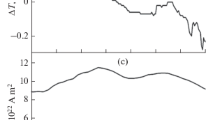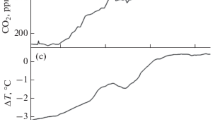Abstract
This paper considers reconstructions of the heliospheric modulation potential, which characterizes solar activity variations, over the past 20 000 years on the basis of radiocarbon data. This time interval includes the period of climate transition from the Last Ice Age to the Holocene and the Holocene itself. The reconstruction process takes into account variations in the global temperature and carbon dioxide content in the Earth’s atmosphere. The variation in the rate of radiocarbon transfer from the ocean to the atmosphere and from the atmosphere to the biosphere is also taken into account. In particular, it is shown that high solar activity in the 13th millennium BC could cause the Meiendorf warming, and a decrease in solar activity could lead to a decrease in the global temperature in the period starting from 3000 BC.




Similar content being viewed by others
REFERENCES
Astaf’eva, N.M., Wavelet analysis: Basic theory and some applications, Phys. Usp., 1996, vol. 39, no. 11, pp. 1085–1108.
Berggren, A.-M., Beer, J., Possnert, G., et al., A 600-year annual 10Be record from the NGRIP ice core, Greenland, Geophys. Res. Lett., 2009, vol. 36, p. L11801.
Claussen, M., Kubatzki, C., Brovkin, V. and Ganopolski, A., Simulation of an abrupt change in Saharan vegetation in the mid-Holocene, Geophys. Res. Lett., 1999, vol. 26, no. 14, pp. 2037–2040.
Crowley, T., Causes of climate change over the past 1000 years, Science, 2000, vol. 289, p. 270.
Crowley, T.J. and Lowery, T.S., How warm was medieval warm period?, Ambio, 2000, vol. 29, pp. 51–54.
Dergachev, V.A. and Kudriavtsev, I.V., Changes in solar activity based on radiocarbon data and climate variations in the interval 8000–1000 BC, J. Phys.: Conf. Ser., 2021, vol. 2103, p. 012035.
Dorman, L.I., Peculiarities of the study of cosmic ray variations by the radioucarbon method, in Trudy 6 Vsesoyuznogo soveshchaniya po probleme “Astrofizicheskie yavleniya i radiouglerod”, Tbilisi 13–15 oktyabrya 1976 g. (Proceedings of the 6th All-Union Meeting on the Problem “Astrophysical Phenomena and Radiocarbon”, Tbilisi, 13–15 October 1976), Tbilisi, 1978, pp. 49–96.
Etheridge, D.M., Steele, L.P., Langenfelds, R.L., et al., Historical CO2 record derived from a spline fit (75 year cutoff) of the Law Dome DSS, DE08, and DE08-2 ice cores, 1998. http://cdiac.ornl.gov/ftp/trends/co2/lawdome.smoothed.yr75.
Fedorov, V.M., Earth insolation variation and its incorporation into physical and mathematical climate models, Phys. Usp., 2019, vol. 62, pp. 32–45.
Knudsen, M.F., Riisager, P., Donadini, F., et al., Variations in the geomagnetic dipole moment during the Holocene and the past 50 kyr, Earth Planet. Sci. Lett., 2008, vol. 272, pp. 319–329.
Kocharov, G.E., Vasilev, V.A., Dergachev, V.A., and Ostryakov, V.M., An 8000-year sequence of galactic cosmic-ray fluctuations, Sov. Astron. Lett., 1983, vol. 9, no. 4, pp. 110–112.
Kudryavtsev, I.V., Reconstruction of heliospheric modulation potential based on data on the content of the cosmogenic isotope 10Be in Greenland ice and the extremes of solar activity from the end the 14th century, Geomagn. Aeron. (Engl. Transl.), 2020, vol. 60, no. 8, pp. 1028–1031.
Kudryavtsev, I.V. and Dergachev, V.A., Radiocarbon data: Reflection of solar activity variations and biosphere changes in the Early Holocene, in Trudy Vserossiiskoi konferentsii po fizike Solntsa “Solnechnaya i solnechno-zemnaya fizika-2016" (Proceedings of the All-Russian Conference on Solar Physics "Solar and Solar–Terrestrial Physics-2016"), GAO RAN, St. Petersburg, 2016, pp. 179–182.
Kudryavtsev, I.V. and Dergachev, V.A., Reconstruction of heliospheric modulation potential based on radiocarbon data in the time interval 17000–5000 year B.C., Geomagn. Aeron. (Engl. Transl.), 2019, vol. 59, no. 8, pp. 1099–1102.
Kudryavtsev, I.V. and Dergachev, V.A., Radiocarbon production rate, heliospheric modulation potential, and climate variations during Middle Holocene, in Trudy Vserossiiskoi ezhegodnoi konferentsii po fizike Solntsa “Solnechnaya i solnechno–zemnaya fizika-2020” (Proceedings of the All-Russian Annual Conference on Solar Physics "Solar and Solar–Terrestrial Physics-2020), GAO RAN, St. Petersburg, 2020, pp. 185–188.
Kudryavtsev, I.V. and Jungner, H., A possible mechanism of the effect of cosmic rays on the formation of cloudiness at low altitudes, Geomagn. Aeron. (Engl. Transl.), 2005, vol. 45, no. 5, pp. 641–648.
Koudriavtsev, I.V., Dergachev, V.A., Nagovitsyn, Yu.A., et al., On the influence of climatic factors on the ratio between the cosmogenic isotope 14C and total carbon in the atmosphere in the past, Geochronometria, 2014, vol. 41, no. 3, pp. 216–222.
Kudryavtsev, I.V., Volobuev, D.M., Dergachev, V.A., et al., Reconstructions of the 14C cosmogenic isotope content of natural archives after the last glacial period, Geomagn. Aeron. (Engl. Transl.), 2016a, vol. 56, no. 7, pp. 858–862.
Kudryavtsev, I.V., Dergachev, V.A., Kuleshova, A.I., et al., Reconstruction of the heliospheric modulation potential and Wolf numbers based on the content of the 14C isotope in tree rings during the maunder and Spörer minimums, Geomagn. Aeron. (Engl. Transl.), 2016b, vol. 56, no. 8, pp. 998–1005.
Kudryavtsev, I.V., Volobuev, D.M., Dergachev, V.A., et al., Reconstruction of the production rate of cosmogenic 14C in the Earth’s atmosphere for 17000– 5000 BC, Geomagn. Aeron. (Engl. Transl.), 2018, vol. 58, no. 7, pp. 925–929.
Kuleshova, A.I., Dergachev, V.A., Kudryavtsev, I.V., et al., Possible influence of climate factors on the reconstruction of the cosmogenic isotope 14C production rate in the Earth’s atmosphere and solar activity in past epochs, Geomagn. Aeron. (Engl. Transl.), 2015, vol. 55, pp. 1071–1075.
Marcott, S.A. and Shakun, J.D., Holocene climate change and its context for the future, Pages Mag., 2015, vol. 23, no. 1, p. 28.
Marcott, S.A., Shakun, J.D., Clark, P.U., and Mix, A.C., A reconstruction of regional and global temperature for the past 11,300 years, Science, 2013, vol. 339, pp. 1198–1201.
Marsh, N. and Svensmark, H., Cosmic rays, clouds and climate, Space Sci. Rev., 2000a, vol. 94, pp. 215–230.
Marsh, N.D. and Svensmark, H., Low cloud properties influenced by cosmic rays, Phys. Rev. Lett., 2000b, vol. 85, no. 23, pp. 5004–5007.
Marsh, N. and Svensmark, H., Solar influence on Earth’s climate, Space Sci. Rev., 2003, vol. 107, pp. 317–325.
Moberg, A., Sonechkin, D.M., Holmgren, K., et al., Highly variable Northern Hemisphere temperatures reconstructed from low- and high-resolution proxy data, Nature, 2005, vol. 433, pp. 613–617.
Monin, A.S. and Shishkov, Yu.A., Istoriya klimata (The History of Climate), Leningrad: Gidrometeoizdat, 1979.
Monin, A.S. and Sonechkin, D.M., Kolebaniya klimata po dannym nablyudenii: troinoi solnechnyi i drugie tsikly (Climate Oscillations According to Observation Data: Triple Sun-Induced and Other Cycles), Moscow: Nauka, 2005.
Monnin, E., Indermuhle, A., Dallenbach, A., et al., Atmospheric CO2 concentrations over the last glacial termination, Science, 2001, vol. 291, pp. 112–114.
Muscheler, R., Adolphi, F., and Nilsson, A., The revised sunspot record in comparison to cosmogenic radionuclide-based solar activity reconstructions, Sol. Phys., 2016, vol. 291, pp. 3025–3043.
Nagovitsyn, Yu.A., Specific features in the effect of solar activity on the Earth’s climate changes, Geomagn. Aeron. (Engl. Transl.), 2014, vol. 54, no. 8, pp. 1010–1013.
Nagovitsyn, Yu.A. and Osipova, A.A., Variations of interplanetary magnetic field on various long time-scales, Mon. Not. R. Astron. Soc., 2020, vol. 492, no. 2, pp. 1914–1918.
Nagovitsyn, Yu.A., Miletsky, E.V., Ivanov, V.G., and Guseva, S.A., Reconstruction of space weather physical parameters on 400-year scale, Cosmic Res., 2008, vol. 46, pp. 283–293.
Ogurtsov, M.G., Solar activity during the Maunder Minimum: Comparison with the Dalton Minimum, Astron. Lett., 2018, vol. 44, pp. 278–288.
Parker, A.G., Gloudie, A.S., Stokes, S., White, K., et al., A record of Holocene climate change from lake geochemical analyses in southeastern Arabia, Quat. Res., 2006, vol. 66, pp. 465–476.
Reimer, P.J., Baillie, M.G.L., Bard, E., et al., IntCal09 and Marine09 radiocarbon age calibration curves, 0–50 000 years cal BP, Radiocarbon, 2009, vol. 51, pp. 1111–1150.
Reimer, P.J., Bard, E., Bayliss, A., et al., IntCal13 and MARINE13 radiocarbon age calibration curves 0–50000 years calBP, Radiocarbon, 2013, vol. 55, no. 4, pp. 1869–1887.
Roth, R. and Joos, F., A reconstruction of radiocarbon production and total solar irradiance from the Holocene 14C and CO2 records: Implications of data and model uncertainties, Clim. Past, 2013, vol. 9, pp. 1879–1909.
Shakun, J.D., Clark, P.U., He, F., et al., Global warming preceded by increasing carbon dioxide concentrations during the last deglaciation, Nature, 2012, vol. 48, pp. 49–55.
Tinsley, A.B., Influence of solar wind on global electric circuit and inferred effects on cloud microphysics, temperature and dynamics in the troposphere, Space Sci. Rev., 2000, vol. 94, pp. 231–258.
Usoskin, I., A history of solar activity over millennia, Living Rev. Sol. Phys., 2008, vol. 5, p. 3.
Usoskin, I.G., Hulot, G., Gallet, Y., et al., Evidence for distinct modes of solar activity, Astron. Astrophys., 2014, vol. 562, p. L10.
Vieira, L.E.A., Solanki, S.K., Krivova, N.A., and Usoskin, I., Evolution of the solar irradiance during the Holocene, Astron. Astrophys., 2011, vol. 531, p. A6.
Webber, W. and Higbie, P., Production of cosmogenic Be nuclei in the Earth’s atmosphere by cosmic rays: Its dependence on solar modulation and the interstellar cosmic ray spectrum, J. Geophys. Res., 2003, vol. 108, no. A9, p. 1355.
Funding
The work on the reconstruction of the heliospheric modulation potential was supported by the state assignment of the Ioffe Institute, subject no. 0040-2019-0025.
The work on the numerical analysis of the contribution of solar activity to climate variations was supported by the Ministry of Science and Higher Education of the Russian Federation, grant no. 075-15-2020-780.
Author information
Authors and Affiliations
Corresponding author
Ethics declarations
The authors declare that they have no conflicts of interest.
Additional information
Translated by M. Chubarova
Rights and permissions
About this article
Cite this article
Kudryavtsev, I.V., Dergachev, V.A. & Nagovitsyn, Y.A. Reconstructions of the Heliospheric Modulation Potential and Earth Climate Variations over the Past 20 000 Years. Geomagn. Aeron. 62, 851–858 (2022). https://doi.org/10.1134/S0016793222070155
Received:
Revised:
Accepted:
Published:
Issue Date:
DOI: https://doi.org/10.1134/S0016793222070155




